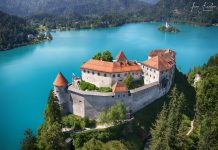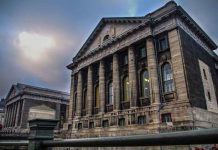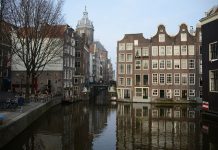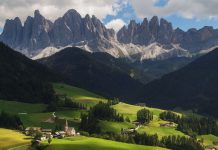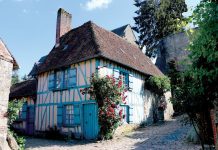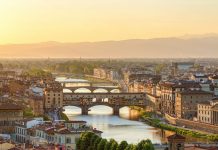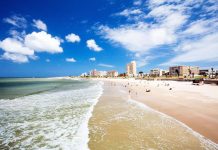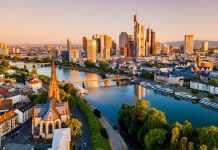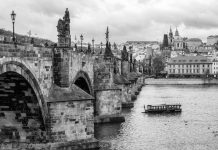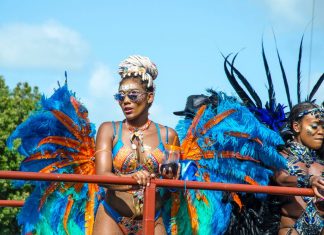The Old Town developed gradually; its plan being drawn up in 1257 after the Tartar invasions. The construction of the fortifications was begun in the 13th century, and it took almost two centuries to envelop the town with a powerful, 3km long chain of double defensive walls complete with 47 towers and 7 main entrance gates plus a wide moat. The system was eventually demolished by the Republic of Krakow between 1822 and 1847 as a display of municipal modernisation and the moat filled up.
A ring-shaped park, the Planty, was laid out on the site. Due to the efforts of Prof. Feliks Radwanski of the Jagiellonian a representative section was preserved. The city is bisected by the Royal Way, the route followed by the coronation procession of the kings of Poland from the Church of St.Florian through to the Wawel and then on to the Paulite Church Na Skalce.
Pl.Matejki:
The Collegiate Church of St.Florian (Kosciol Floriana) stands at the northern end of the square, the centre of the Kleparz district. Built in 1185, legend has it at the spot where the relics of St.Florian miraculously grew too heavy to be taken any further, its present appearance is the result of a Baroque rebuilding after the Swedish Wars. Since the 16th.century it has been the University Collegiate. The coronation route began here where the rector with the Senate of the University would welcome the new king. The treasury contains a valuable relic gained as booty after Grunwald and presented by Jagiello. Karol Wojtyla, the future Pope John Paul II, was vicar here between 1945-51.
The Monument to the Battle of Grunwald (Pomnik Grunwaldzki) by Marian Konieczny, dedicated by Ignacy Paderewski, President of Poland, in 1910 to mark the 500th anniversary of the defeat of the Teutonic Order. The equestrian figure is Wladyslaw Jagiello, around the base are the Lithuanian Prince Witold, the defeated Grand Master, and Polish and Lithuanian Knights.The monument was destroyed by the Nazis but reconstructed in 1976. Below it is the simpler Monument to the Unknown Soldier. There is an excellent view of the Barbakan from here.
No.13, the Academy of Art is associated with Matejko, Wyspianski, Mehoffer as well as Kantor, Wajda and Nowosielski.
The Barbakan, one of the very few surviving structures of its kind in Europe, was built about 1498 based on Arabic rather than European defensive architecture. It is a moated cylindrical brick structure with an inner courtyard and seven turrets. Its 3-metre thick walls have 130 loopholes. It was originally linked to the walls by a covered passage. On its eastern wall is a tablet commemorating the feat of the Krakow burgher, Marcin Oracewicz who, during the Confederation of Bar, defended the town against the Russians and shot the enemy colonel, Panin.
The Florian Gate (Brama Florianska) marks the edge of the Stare Miasto. The tower was built before 1307. It was heightened in brick in the late 15th century and a Baroque roof added in 1657. There is a stone relief of St.Florian facing the town along the Florianska. The walls lead east to the Haberdashers’ Tower; Pasamonikow.
Ulica Szpitalna/Holy Ghost Square (Pl.sw.Ducha):
The burghers of Krakow established a hospital in the northeast of the Stary Miasto but very little remains being demolished to make way for the Juliusz Slowacki Theatre (Teatr im.Juliusza Slowackiego) whose design was inspired by the Paris Opera House. Built between 1891-3, designed by Jan Zawiejski, municipal architect 1900-22. The front elevation bears allegorical figures of Poetry, Drama, and Comedy. In front stands a monument to the comedy writer, Aleksander Fredro. The foyer is hung with portraits of famous theatrical figures and the painting on the stage curtain (1894) is by Siemiradzki. The first cinema show in Poland was held here in 1896.
The Church of the Holy Cross (Kosciol sw.Krzyza) built between 1186-1207, has a 14th.century chancel attached to a dramatic nave whose L.Gothic vaulting (constructed in 1528) is supported by a single pier, a palm-like vault reminiscent of some English chapter houses. Furnishings are mainly Baroque but there are Gothic sculptures and paintings, e.15th.century murals and a bronze font by Jan Freudenthal, dating from 1423, decorated with Adam and Eve. There is a monument to the world-famous Polish actress, Helena Modrzejewska.
No.5 Pl.sw.Ducha, the Dom Pod Krzyzem, built 1474 as a hospital of St.Roch is now a museum (est.1899) exhibiting the history of Krakow’s theatres from the Middle Ages to the present day..
No.24 ul.Szpitalna, the Orthodox Church is a house whose first floor has been converted. Some of the decoration is by Jerzy Nowosielski whose modern painting is strongly influenced by traditional icons (he has also executed murals in Lourdes). Before WW2 the same house was a synagogue.
The walls lead west to the Joiners’ Gate;Stolarska separated from the even older Carpenters’ Gate;Ciesielska by the Municipal Arsenal built in 1565-66 (itself linked by a covered passageway across ul.Pijarska with the Czartoryski Palace).
Ulica Pijarska:
Along the walls between the Brama Florianska and the Arsenal there is an open-air gallery of paintings by artists often associated with the Academy of Fine Arts; the “Florian Walls” exhibition.
The Czartoryski Palace/Museum, ul.Pijarska 15, was converted in the 19th century from a number of burghers’ houses. Nowadays it houses a department of the National Museum – the Czartoryski Collection, the oldest and one of the richest in Poland and Krakow’s finest, containing momentos of national heroes, a collection of Greek, Egyptian and Etruscan antique art, Oriental armour seized after the Battle of Vienna (1683) and several important paintings including Leonardo Da Vinci’s Lady with an Ermine (c.1485) and Rembrandt’s Landscape with the Good Samaritan (1638). The collection was founded by Izabela Czartoryska in Pulawy at the beginning of the 19th century, was transferred to Paris after the November Insurrection of 1830 (in which the family was deeply implicated), and then to Krakow. The Nazis seized it and took it to Germany, and not all the exhibits have been recovered.
The Piarist Church of the Transfiguration (Kosciol Pijarow Przemienieria Panskiego), is a Baroque church cum monastery built for the Piarist order in 1718-59 to the design of Kasper Bazanka and Francesco Placidi. There is an extensive crypt under the building in which bodies used to be kept before burial. The altar-pieces are by Szymon Czechowicz and Andrzej Radwanski, Polish 17th.century painters and the paintings inside the vaults are by Franz Eckstein of Brno. On the balustrade, over the entrance to the crypt, stands the bust of Stanislaw Konarski.
Ul.sw.Jana:
No. 15,The Lubomirski Palace (next door to the Czartoryski Palace) has a Neoclassical facade of 1873-74 concealing what were originally three burghers’ houses. The fine entrance hall has decorative plasterwork.
No.11, the Wodzicki Palace is surmounted by a balustraded attic with allegorical figures. The Austrian Hofkommissar, Count Maurycy Deym, was living here in 1848 when he was forced to release Polish prisoners being held for their liberal and democratic views, by Prince Adam Potocki and a deputation of Krakow citizens.
No.20, across the road, known as the Popiel Palace or the Kollataj House (Dom Kollatajowski), was formed in 1774 by merging two burghers’ houses. In the second half of the 18th.century the house was owned by the priest Hugo Kollataj. In 1817 it passed on to Kosciuszko’s friend, Konstanty Popiel, alumnus of the School of Cadets, and later to his son Pawel, who took part in the 1830 Uprising. At that time the house became the centre of social life in Krakow. The facade is ornamented with a Baroque doorway, flanked by atlantes, is of a>
No.12, the Krakow History Museum (Wed.-Sun) is situated in the 17th.century Krauze House (Kamienica Krauzowska). It was originally a Gothic building but remodelled by Giovanni Petrini and Trevano in 1611. The house has a doorway with a semicircular top dating from the 17th.century. Inside, numerous fragments are preserved such as beamed ceilings and ornamental grilles. In 1913 the house was purchased by Klemens Bakowski, a student of Krakow’s history, who donated it to the Society of Lovers of the History and Monuments of Krakow. The main part of the collection is in the Krzysztofory Palace but the exhibits here illustrate the history of Krakow’s municipality and her many guilds and associations (foremost being the Gun Cock Fraternity whose silver cockerel prize was donated by the king in 1565).
St.John’s Church (Kosciol sw.Jana) is a little Baroque church (1621-3) set at an angle on earlier Romanesque foundations at the corner with ul.sw.Tomasza. The interior fittings are 18th.century. The main altar painting is of The Mother of God redeeming the Slaves. Nearby is the cloister of the Presentation Sisters.
Ulica Florianska:
No.45 ul.Florianska, Jama Michalika is a cafe (selling wonderful – alcoholic – lody), cabaret and major literary landmark. Originally the house belonged to the Belza family and later to the Order of the Holy Ghost. In 1895, Jan Michalik opened a confectionery and the Lwowska Cafe which became a favoured meeting-place of Bohemian circles, especially the Mloda Polska group. In 1905 Jan Kiesilewski started the legendary Zielony Balonik (Green Balloon) cabaret featuring Tadeusz Boy Zelenski. Its Art Nouveau interior, furnishings and stained glass (by Henryk Uziemblo) have hardly changed since Austro-Hungarian days. Its decoration was overseen by Franciszek Maczynski and the set designer, Karol Frycz.
No.41, the 16th century Dom Jana Matejki; the Matejko House is a museum (Wed- Sun) to the famous history painter who lived here from 1873-93; it was set up in 1893 (seven years after his death). It originally belonged to the families of Krakow craftsmen and was purchased by the end of the 18th century by the Matejko family. Its Baroque facade was designed by Tomasz Prylinski and Jan Matejko himself. The museum contains mementos,some paintings and drawings, and two rooms preserved in their original state.
No. 17 has chains outside, a rare survival of an ancient city-wide system of crowd control.
Across the road at No 14 is the Hotel Pod Roza (Under the Rose) – many buildings in Krakow are named after the carvings appearing on the walls of the buildings or over the doorways.The oldest hotel in Krakow, many distinguished visitors have stayed here: Tzar Alexander I; Franz Liszt; Fausto Sozzini, the Sienese religious reformer who came to Poland in 1579 and spread Antitrinitarianism (Socinianism) among the nobility. Over the doorway is an inscription; “May this house stand until an ant drinks the oceans dry and a tortoise circles the world”.
Among the older houses is No.13, the house of the Kmita family, with fine Renaissance windows.
No.5, the 15th century House of the Mother of God (Dom Pod Matka Boska), has a niche with a stone Renaissance figure of the Virgin and Child.
At the corner of the Rynek, No.1, the House of the Moor (Kamienica Pod Murzynkiem) has coloured plaster reliefs of American Indians.
At No.3 Pl.Mariacki (facing the Florianska side of the Mariacki) the Hippolytus House (Kamienica Hipolita) has a courtyard with a 17th century wooden gallery and a room on the first floor with plasterwork by Fontana.
No.4, the Prelate’s House (Pralatowka) is the residence of the archpriest of the Mariacki. It has a facade covered by a painted Baroque decoration simulating diamond-pointed rustication and a 17th century attic. The doorway leads through to an entrance hall with 17th century plasterwork and paintings by Hans Suss von Kulmbach (commissioned by Jan Boner for the church).
The tranquil Maly Rynek was once the second-largest marketplace in town, trading mainly in meat; some of the ancient butcher’s booths can still be seen.
No.7, Kamienica Mansjonarska, was originally a Gothic building, rebuilt in the 16th and 19th.centuries. In the courtyard are Renaissance galleries on columns.

